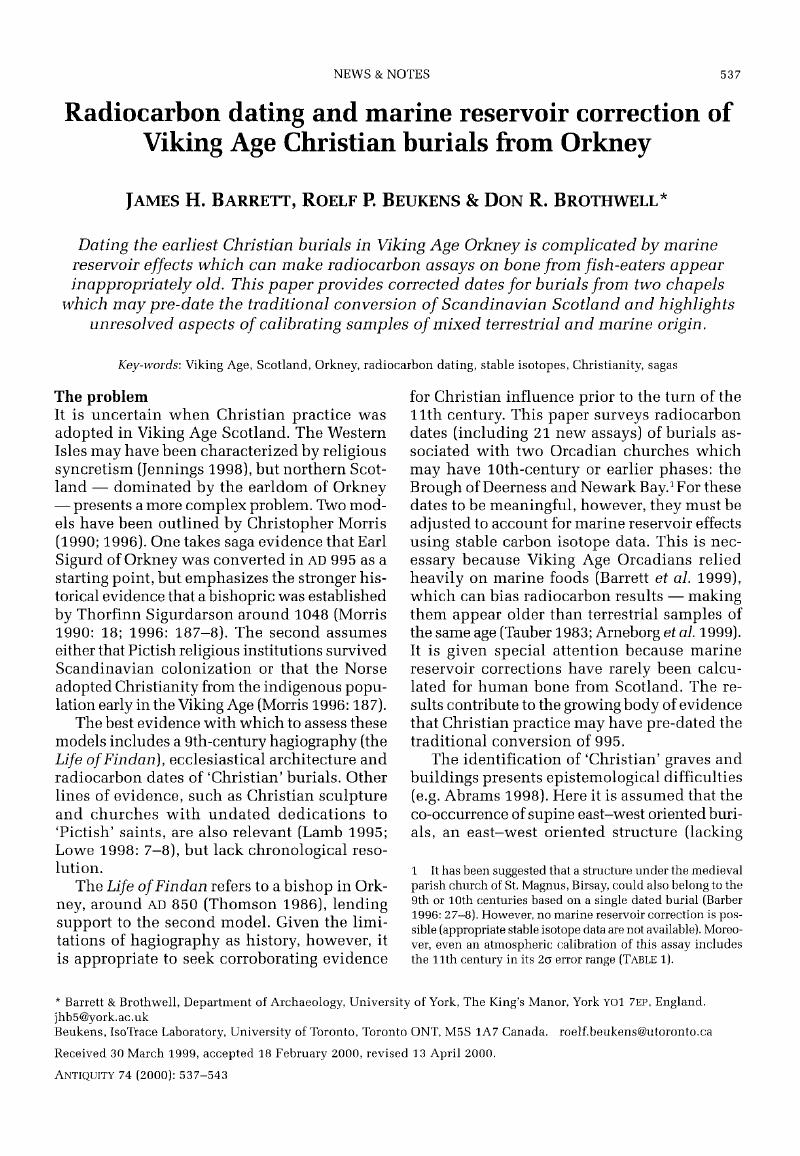Crossref Citations
This article has been cited by the following publications. This list is generated based on data provided by Crossref.
Taylor, G.Michael
Widdison, Stephanie
Brown, Ivor N
Young, Douglas
and
Molleson, Theya
2000.
A Mediaeval Case of Lepromatous Leprosy from 13–14th Century Orkney, Scotland.
Journal of Archaeological Science,
Vol. 27,
Issue. 12,
p.
1133.
Barrett, James H.
Beukens, Roelf P.
and
Nicholson, Rebecca A.
2001.
Diet and ethnicity during the Viking colonization of northern Scotland: evidence from fish bones and stable carbon isotopes.
Antiquity,
Vol. 75,
Issue. 287,
p.
145.
Schulting, Rick J.
and
Richards, Michael P.
2002.
The wet, the wild and the domesticated: The Mesolithic–Neolithic transition on the west coast of Scotland.
European Journal of Archaeology,
Vol. 5,
Issue. 2,
p.
147.
Barrett, James H.
and
Richards, Michael P.
2004.
Identity, Gender, Religion and Economy: New Isotope and Radiocarbon Evidence for Marine Resource Intensification in Early Historic Orkney, Scotland, UK.
European Journal of Archaeology,
Vol. 7,
Issue. 3,
p.
249.
Milner, N.
Craig, O. E.
Bailey, G. N.
Pedersen, K.
and
Andersen, S. H.
2004.
Something fishy in the Neolithic? A re-evaluation of stable isotope analysis of Mesolithic and Neolithic coastal populations.
Antiquity,
Vol. 78,
Issue. 299,
p.
9.
Ascough, Philippa
Cook, Gordon
and
Dugmore, Andrew
2005.
Methodological approaches to determining the marine radiocarbon reservoir effect.
Progress in Physical Geography: Earth and Environment,
Vol. 29,
Issue. 4,
p.
532.
Pearson, Mike Parker
Chamberlain, Andrew
Craig, Oliver
Marshall, Peter
Mulville, Jacqui
Smith, Helen
Chenery, Carolyn
Collins, Matthew
Cook, Gordon
Craig, Geoffrey
Evans, Jane
Hiller, Jen
Montgomery, Janet
Schwenninger, Jean-Luc
Taylor, Gillian
and
Wess, Timothy
2005.
Evidence for mummification in Bronze Age Britain.
Antiquity,
Vol. 79,
Issue. 305,
p.
529.
Craig, O.E.
Taylor, G.
Mulville, J.
Collins, M.J.
and
Parker Pearson, M.
2005.
The identification of prehistoric dairying activities in the Western Isles of Scotland: an integrated biomolecular approach.
Journal of Archaeological Science,
Vol. 32,
Issue. 1,
p.
91.
Richards, M.P.
Fuller, B.T.
and
Molleson, T.I.
2006.
Stable isotope palaeodietary study of humans and fauna from the multi-period (Iron Age, Viking and Late Medieval) site of Newark Bay, Orkney.
Journal of Archaeological Science,
Vol. 33,
Issue. 1,
p.
122.
Ascough, P. L.
Cook, G. T.
Church, M. J.
Dugmore, A. J.
Arge, S. V.
and
McGovern, T. H.
2006.
Variability in North Atlantic marine radiocarbon reservoir effects at c. AD 1000.
The Holocene,
Vol. 16,
Issue. 1,
p.
131.
Richards, Michael P.
Greer, Sheila
Corr, Lorna T.
Beattie, Owen
Mackie, Alexander
Evershed, Richard P.
Finster, Al von
and
Southon, John
2007.
Radiocarbon Dating and Dietary Stable Isotope Analysis of Kwaday Dän Ts'inchí.
American Antiquity,
Vol. 72,
Issue. 4,
p.
719.
JAY, MANDY
2008.
IRON AGE DIET AT GLASTONBURY LAKE VILLAGE: THE ISOTOPIC EVIDENCE FOR NEGLIGIBLE AQUATIC RESOURCE CONSUMPTION.
Oxford Journal of Archaeology,
Vol. 27,
Issue. 2,
p.
201.
Hunter, Fraser
2008.
Jet and Related Materials in Viking Scotland.
Medieval Archaeology,
Vol. 52,
Issue. 1,
p.
103.
Barrett, James
Johnstone, Cluny
Harland, Jennifer
Van Neer, Wim
Ervynck, Anton
Makowiecki, Daniel
Heinrich, Dirk
Hufthammer, Anne Karin
Enghoff, Inge Bødker
Amundsen, Colin
Christiansen, Jørgen Schou
Jones, Andrew K.G.
Locker, Alison
Hamilton-Dyer, Sheila
Jonsson, Leif
Lõugas, Lembi
Roberts, Callum
and
Richards, Michael
2008.
Detecting the medieval cod trade: a new method and first results.
Journal of Archaeological Science,
Vol. 35,
Issue. 4,
p.
850.
OLSEN, JESPER
RASMUSSEN, PETER
and
HEINEMEIER, JAN
2009.
Holocene temporal and spatial variation in the radiocarbon reservoir age of three Danish fjords.
Boreas,
Vol. 38,
Issue. 3,
p.
458.
Barrett, James H.
and
Slater, Adam
2009.
New Excavations at the Brough of Deerness: Power and Religion in Viking Age Scotland.
Journal of the North Atlantic,
Vol. 2,
Issue. ,
p.
81.
Dewar, Genevieve
and
Pfeiffer, Susan
2010.
Approaches to Estimating Marine Protein in Human Collagen for Radiocarbon Date Calibration.
Radiocarbon,
Vol. 52,
Issue. 4,
p.
1611.
Ascough, Philippa L.
Church, Mike J.
Cook, Gordon T.
Dunbar, Elaine
Gestsdóttir, Hildur
McGovern, Thomas H.
Dugmore, Andrew J.
Friðriksson, Adolf
and
Edwards, Kevin J.
2012.
Radiocarbon reservoir effects in human bone collagen from northern Iceland.
Journal of Archaeological Science,
Vol. 39,
Issue. 7,
p.
2261.
Arneborg, Jette
Lynnerup, Niels
Heinemeier, Jan
Møhl, Jeppe
Rud, Niels
and
Sveinbjörnsdóttir, Árný E.
2012.
Norse Greenland Dietary Economy ca. AD 980-ca. AD 1450: Introduction.
Journal of the North Atlantic,
Vol. 301,
Issue. ,
p.
1.
Valenzuela, Alejandro
and
Alcover, Josep Antoni
2013.
Radiocarbon evidence for a prehistoric deliberate translocation: the weasel (Mustela nivalis) of Mallorca.
Biological Invasions,
Vol. 15,
Issue. 4,
p.
717.





